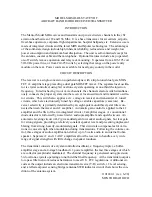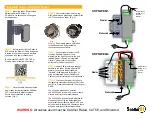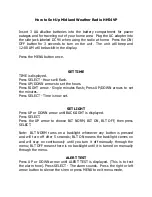
MODEL MB VHF AIRCRAFT BAND
RADIO RECEIVER/TRANSMITTER
INSTALLATION
Select a desk, counter, shelf or table top on which to place the Model MB, convenient to
the operator but inaccessible to unauthorized persons. The MB is also available with op-
tional relay rack mounting. Allow several inches space behind and above the unit for air
circulation; this is especially important if heavy use is anticipated. Plug the line cord into a
properly grounded standard 3-wire electrical outlet. If an extension cord is needed, a 3-
wire type should be used. For operation outside of North America, an appropriate line
cord must be used, and to prevent damage to the radio be certain that the voltage selector at
the power inlet is set for 220 volts if that is the voltage available at the site.
The performance of both the receiver and transmitter is affected considerably by the an-
tenna and coaxial cable installation. For greatest range in all directions, the antenna should
be as high as practical, consistent with regulations concerning heights of structures near
the airport. If possible the antenna should be higher than nearby buildings to prevent
shielding or “shadowing”. Antenna height is especially important for communications
with lower altitude aircraft, or if there is higher terrain within desired communications dis-
tances.
The antenna for the Model MB should be located well away from other communications
antennas if at all possible. Strong nearby signals from transmitters on other channels can
block or interfere with reception in any radio receiver. If there are other aviation bad
transmitters and antennas on the airport, the minimum recommended distances between
these and the MB antenna depend on the frequency separations, and are as follows:
frequency separation distance between antennas
less than 0.5 MHz 0.5 miles (800 meters)
0.5 to 2 Mhz 1000 ft. (300 meters)
2 to 5 Mhz 500 ft. (150 meters)
over 5 Mhz 300 ft. (100 meters)
If it is impossible to locate the MB’s antenna sufficiently far from other antennas, and in-
terference results, consult with Mentor Radio Co. (440-942-2025).
The coaxial cable (“coax”) connecting the antenna to the Model MB causes signal attenua-
tion proportional to its length in both receive and transmit modes, so that a short cable is
desirable. This factor often conflicts with the need to locate the antenna high, away from
structures and distant from other antennas. For longer cables, coax types with lower signal
loss should be used. Type RG-58 coax is suitable for lengths up to 50 feet (15 meters).
Type RG-8, or similar, can be used for lengths to 150 feet (45 meters). For more than 150
feet, consult with Mentor Radio Co. about very low loss cables.
1101242-2
(rev.
6-98)

























